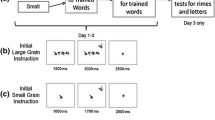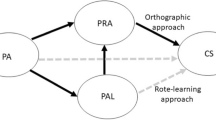Abstract
Initial instruction emphasizing large grain units (i.e., words) showed distinct advantages over small grain instruction for English-speaking adults learning to read an artificial orthography (Brennan and Booth in Read Writ 28(7):917–938, 2015. https://doi.org/10.1007/s11145-015-9555-2). The current study extends this research by training 34 English-speaking adults to read Russian Cyrillic given initial instruction emphasizing either large or small units (words or letters). Results reveal no differences on word learning, but higher accuracy on letter-phoneme matching given letter-based instruction and higher accuracy on rime-rhyme matching given word-based instruction. Differences in phonological awareness (PA) skill showed that higher PA skill resulted in higher accuracy and slower reaction times only for the adults given the instruction with the word emphasis, suggesting that adults with high PA skill given word-based instruction may engage in time intensive small grain analyses (e.g., grapheme-phoneme correspondence) even when their attention is directed to larger grain units. Overall, these results extend previous findings and reveal that word and letter-based instruction each have distinct advantages for facilitating increased sensitivity to either letters/phonemes or rimes/rhymes when adults are learning a natural second (L2) consistent alphabetic orthography.


Similar content being viewed by others
References
Abu-Rabia, S. (2001). Testing the interdependence hypothesis among native adult bilingual Russian-English students. Journal of Psycholinguistic Research, 30(4), 437–455. https://doi.org/10.1023/A:1010425825251.
Adams, M. J. (1994). Beginning to read: Thinking and learning about print. Cambridge: MIT Press.
Akamatsu, N. (1999). The effects of first language orthographic features on word recognition processing in English as a second language. Reading and Writing, 11(4), 381–403. https://doi.org/10.1023/A:100805352.
Bishop, C. H. (1964). Transfer effects of word and letter training in reading. Journal of Verbal Learning and Verbal Behavior, 3, 215–221.
Bitan, T., & Booth, J. (2012). Offline improvement in learning to read a novel orthography depends on direct letter instruction. Cognitive Science, 36(5), 896–918. https://doi.org/10.1111/j.1551-6709.2012.01234.x.
Bitan, T., & Karni, A. (2003). Alphabetical knowledge from whole words training: Effects of explicit instruction and implicit experience on learning script segmentation. Cognitive Brain Research, 16, 323–337. https://doi.org/10.1016/S0926-6410(02)00301-4.
Bitan, T., & Karni, A. (2004). Procedural and declarative knowledge of word recognition and letter decoding in reading an artificial script. Cognitive Brain Research, 19(3), 229–243. https://doi.org/10.1016/j.cogbrainres.2004.01.001.
Bitan, T., Manor, D., Morocz, I., & Karni, A. (2005). Effects of alphabeticality, practice and type of instruction on reading an artificial script: An fMRI study. Cognitive Brain Research, 25(1), 90–106. https://doi.org/10.1016/j.cogbrainres.2005.04.014.
Boulware-Gooden, R., Joshi, R., & Grigorenko, E. (2015). The role of phonology, morphology, and orthography in english and russian spelling. Dyslexia, 21(2), 142–161. https://doi.org/10.1002/dys.1498.
Brennan, C., & Booth, J. (2015). Large grain instruction and phonological awareness skill influence rime sensitivity, processing speed, and early decoding skill in adult L2 learners. Reading and Writing, 28(7), 917–938. https://doi.org/10.1007/s11145-015-9555-2.
Durgunoglu, A. Y., Nagy, W. E., & Hancin-Bhatt, B. J. (1993). Cross-language transfer of phonological awareness. Journal of Educational Psychology, 85, 453–465.
Ettlinger, M., Morgan-Short, K., Faretta-Stutenberg, M., & Wong, P. (2016). The relationship between artificial and second language learning. Cognitive Science, 40(4), 822–847. https://doi.org/10.1111/cogs.12257.
Goodwin, A., August, D., & Calderon, M. (2015). Reading in multiple orthographies: differences and similarities in reading in Spanish and English for English Learners. Language Learning, 65(3), 596–630. https://doi.org/10.1111/lang.12127.
Goswami, U., Ziegler, J., Dalton, L., & Schneider, W. (2003). Nonword reading across orthographies: How flexible is the choice of reading units? Applied Psycholinguistics, 24(02), 235–247. https://doi.org/10.1017/S0142716403000134.
Hirshorn, E., & Fiez, J. (2014). Using artificial orthographies for studying cross-linguistic differences in the cognitive and neural profiles of reading. Journal of Neurolinguistics, 31, 69–85. https://doi.org/10.1016/j.jneuroling.2014.06.006.
Katz, L., & Frost, R. (1992). The reading process is different for different orthographies: The orthographic depth hypothesis. Advances in psychology - Amsterdam, 94, 67.
Knafle, J. D., & Legenza, A. (1978). External generalizability of inquiry involving artificial orthography. American Educational Research Journal, 15, 331–347. https://doi.org/10.2307/1162471.
Koda, K. (2007). Reading and language learning: Crosslinguistic constraints on second language reading development. Language Learning, 57(s1), 1–44. https://doi.org/10.1111/0023-8333.101997010-i1.
Lukatela, G., & Turvey, M. (1998). Reading in two alphabets. American Psychologist, 53(9), 1057. https://doi.org/10.1037/0003-066X.53.9.1057.
Marian, V., & Kaushanskaya, M. (2004). Mapping written input onto orthographic representations: The case of bilinguals with partially overlapping orthographies. In Forbus, K., Gentner, D., & Regier, T. (Eds.), Proceedings of the Twenty-sixth Annual Conference of the Cognitive Science Society (pp. 654–659). Lawrence Erlbaum. Retrieved on April 15, 2019, from https://cognitivesciencesociety.org/wp-content/uploads/2019/01/CogSci04.pdf.
Nassaji, H. (2011). Issues in second-language reading: Implications for acquisition and instruction. Reading Research Quarterly, 46(2), 173–184. https://doi.org/10.1598/RRQ.46.2.5.
Psychology Software Tools, Inc. [E-Prime 3.0]. (2016). Retrieved May 4, 2017, from https://www.pstnet.com.
Schmalz, X., Beyersmann, E., Cavalli, E., & Marinus, E. (2016). Unpredictability and complexity of print-to-speech correspondences increase reliance on lexical processes: more evidence for the orthographic depth hypothesis. Journal of Cognitive Psychology, 28(6), 1–15. https://doi.org/10.1080/20445911.2016.1182172.
Schwartz, M., Kahn-Horwitz, J., & Share, D. (2014). Orthographic learning and self-teaching in a bilingual and biliterate context. Journal of Experimental Child Psychology, 117, 45–58. https://doi.org/10.1016/j.jecp.2013.08.008.
Taylor, J., Plunkett, K., & Nation, K. (2011). The influence of consistency, frequency, and semantics on learning to read: An artificial orthography paradigm. Journal of Experimental Psychology. Learning, Memory, and Cognition, 37(1), 60. https://doi.org/10.1037/a0020126.
Torgesen, J. K., Wagner, R. K., & Rashotte, C. A. (1999). Test of word reading efficiency (TOWRE). Austin, TX: Pro-Ed.
Wagner, R. K., Torgesen, J. K., & Rashotte, C. A. (1999). Comprehensive test of phonological processing (CTOPP). Austin, TX: Pro-Ed.
Wise, J., Yoncheva, Y., & McCandliss, B. D. (2011). Effects of preference and strategy on learning to read an artificial script. Indiana University Undergraduate Journal of Cognitive Science, 6, 38–47.
Ziegler, J., & Goswami, U. (2005). Reading acquisition, developmental dyslexia, and skilled reading across languages: A psycholinguistic grain size theory. Psychological Bulletin, 131(1), 3. https://doi.org/10.1037/0033-2909.131.1.3.
Ziegler, J., & Goswami, U. (2006). Becoming literate in different languages: Similar problems, different solutions. Developmental Science, 9(5), 429–436. https://doi.org/10.1111/j.1467-7687.2006.00509.x.
Acknowledgements
This project was partially funded by a graduate student research award granted to Jennifer Kiskin by the University of Colorado Boulder’s Center to Advance Research and Teaching in the Social Sciences. This study was conducted as part of a master’s thesis completed by Jennifer Kiskin under the direction of Christine Brennan at the University of Colorado, Boulder. The authors would also like to acknowledge Tina Meyers-Denman and Pui Fong Kan, both of whom served on the thesis committee for Ms. Kiskin’s thesis and provided informative feedback and suggestions related to the design of this study. We would also like to thank Samantha M. Bartolo and Priscilla Jane Kurtz Williams for their help with data collection and Annaliese Miller for her help editing the manuscript.
Author information
Authors and Affiliations
Corresponding author
Additional information
Publisher's Note
Springer Nature remains neutral with regard to jurisdictional claims in published maps and institutional affiliations.
Appendix
Appendix
See Fig. 3.
Rights and permissions
About this article
Cite this article
Brennan, C., Kiskin, J. Distinct Benefits Given Large Versus Small Grain Orthographic Instruction for English-Speaking Adults Learning to Read Russian Cyrillic. J Psycholinguist Res 49, 915–933 (2020). https://doi.org/10.1007/s10936-019-09684-5
Published:
Issue Date:
DOI: https://doi.org/10.1007/s10936-019-09684-5





